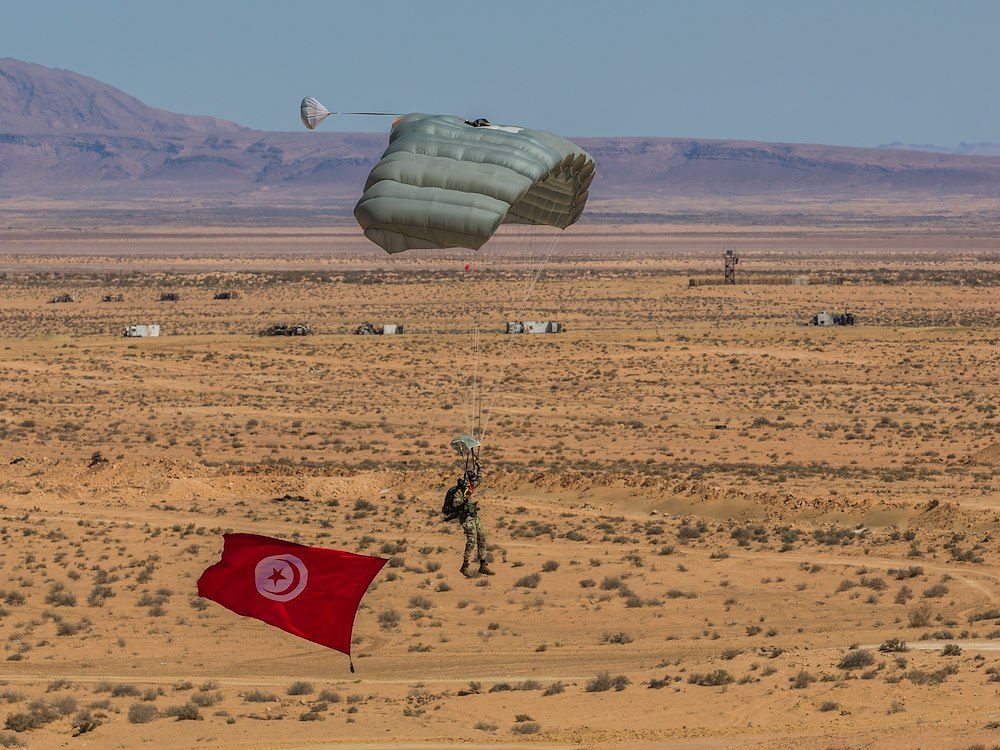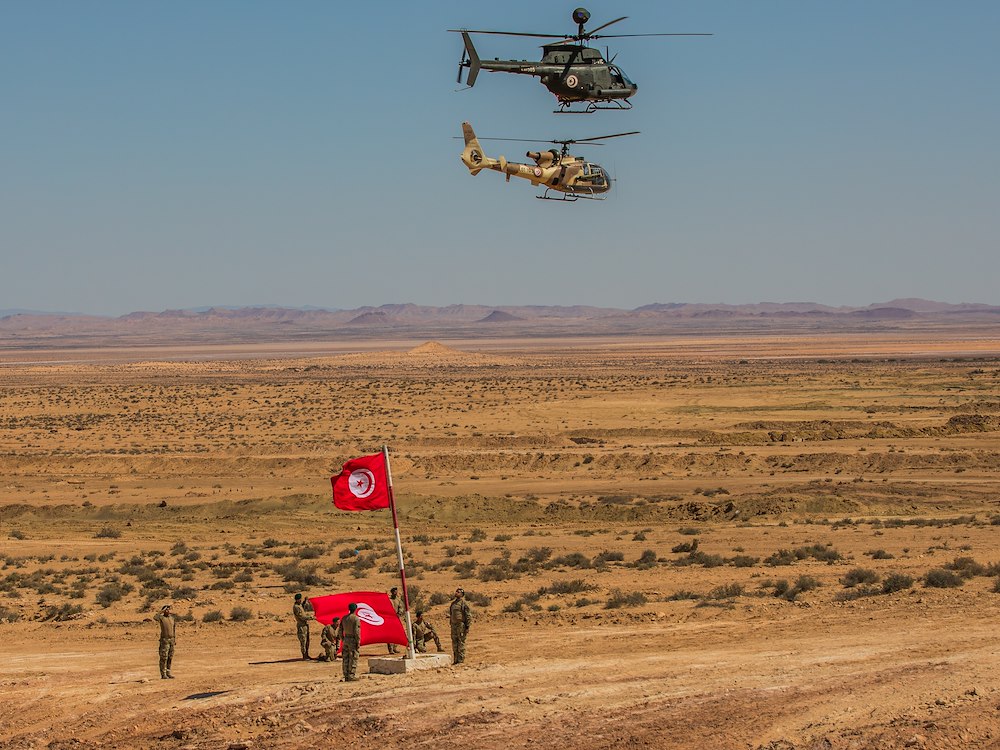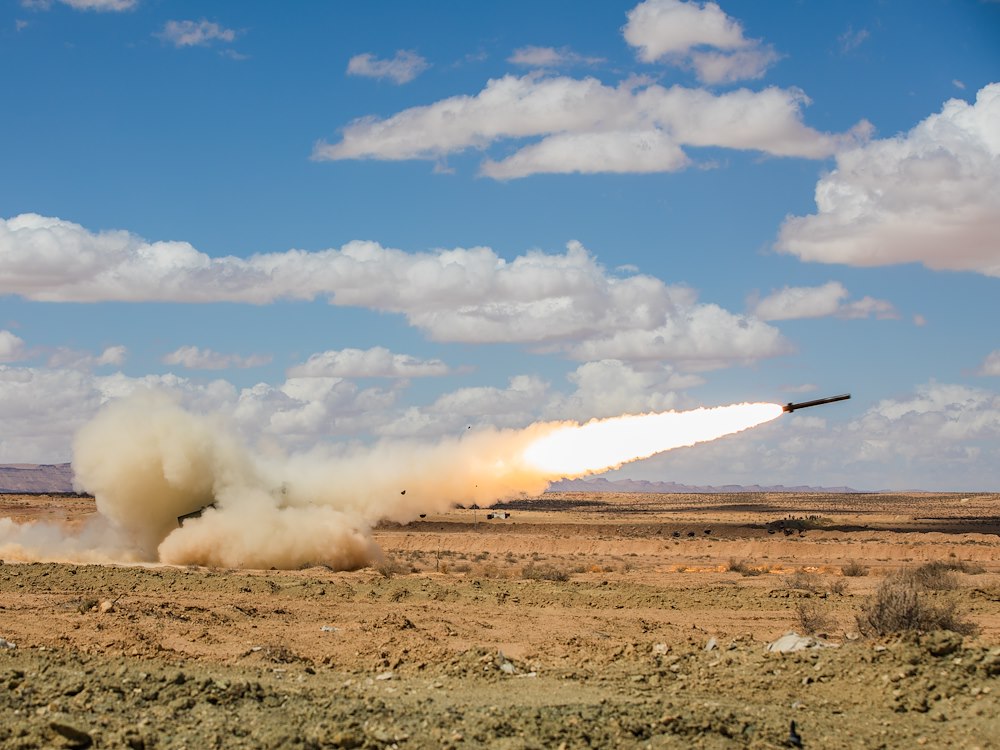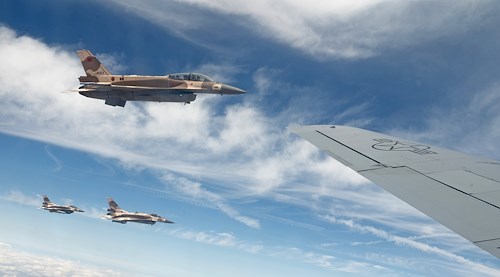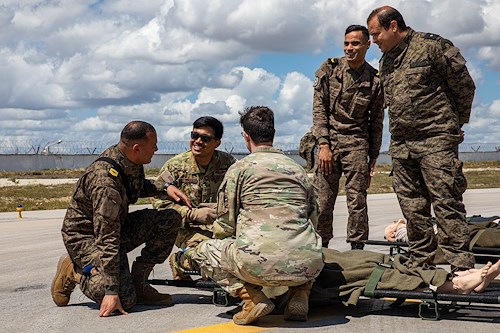Gallery contains 5 images
×
Photo 1 of 5
U.S. Army Southern European Task
Tunisian Special Forces, bearing their national flag, perform a free jump into the area of operations during distinguished visitors day in Ben Ghilouf, Tunisia, on May 10, 2024, as part of African Lion 2024. African Lion 2024 marks the 20th anniversary of U.S. Africa Command’s premier joint exercise led by U.S. Army Southern European Task Force, Africa (SETAF-AF), running from April 19 to May 31 across Ghana, Morocco, Senegal, and Tunisia, with over 8,100 participants from 27 nations and NATO contingents. (U.S. Army photo by Sgt. Lukas Sparks)
Photo by: Spc. Lukas Sparks
Photo 2 of 5
U.S. Army Southern European Task
Tunisian Bell OH-58 Kiowa Warrior and Gazelle helicopters fly over Tunisian Special Forces as they raise the Tunisian flag, concluding the distinguished visitors day in Ben Ghilouf, Tunisia, on May 10, 2024. African Lion 2024 celebrates its 20th anniversary as a premier joint exercise of U.S. Africa Command, led by U.S. Army Southern European Task Force, Africa (SETAF-AF). The exercise spans from April 19 to May 31 across Ghana, Morocco, Senegal, and Tunisia, involving over 8,100 participants from 27 nations and NATO contingents. (U.S. Army photo by Sgt. Lukas Sparks)
Photo by: Spc. Lukas Sparks
Photo 3 of 5
U.S. Army Southern European Task
The M142 High Mobility Artillery Rocket System (HIMARS) fires live rounds during an air-to-ground rehearsal exercise in Ben Ghilouf, Tunisia May 09, 2024. African Lion 2024 marks the 20th anniversary of U.S. Africa Command’s premiere joint exercise led by U.S. Army Southern European Task Force, Africa (SETAF-AF), running from April 19 to May 31 across Morocco, Ghana, Senegal and Tunisia, with over 8,100 participants from 27 nations and NATO contingents. (U.S. Army photo by Sgt. Lukas Sparks)
Photo by: Spc. Lukas Sparks
Photo 4 of 5
U.S. Army Southern European Task
U.S. Army Maj. Gen. Todd Wasmund (far left), commanding general of U.S. Army Southern European Task Force, Africa (SETAF-AF), Tunisian Armed Forces Gen. Mohamed El Ghoul (center left), commander of the Tunisian Land Army, and Joey Hood (far right), U.S. Ambassador to the Republic of Tunisia, present Col. Drew Conover, SETAF-AF exercise director, with a certificate for his efforts on a successful African Lion 2024 (AL24) in Ben Ghilouf, Tunisia, May 10, 2024. AL24 marks the 20th anniversary of U.S. Africa Command’s premiere joint exercise led by SETAF-AF, running from April 19 to May 31 across Ghana, Morocco, Senegal and Tunisia, with over 8,100 participants from 27 nations and NATO contingents. (U.S. Army photo by Capt. Logan Whorton)
Photo by: 1st Lt. Logan Whorton
Photo 5 of 5
U.S. Army Southern European Task
U.S. Army Maj. Gen. Todd Wasmund, commanding general of U.S. Army Southern European Task Force, Africa (SETAF-AF), shakes hands with a high-ranking member of the Tunisian Armed Forces in Ben Ghilouf, Tunisia, on May 10, 2024. African Lion 2024 marks the 20th anniversary of U.S. Africa Command’s premier joint exercise led by SETAF-AF, running from April 19 to May 31 across Ghana, Morocco, Senegal, and Tunisia, with over 8,100 participants from 27 nations and NATO contingents. (U.S. Army photo by Spc. Trevor Seiler)
Photo by: Pfc. Trevor Seiler
TUNIS, Tunisia – Friendly forces identified several enemy four-by-four vehicles and an enemy air defense weapon, considered a high-value target, during the final event of African Lion 2024 (AL24) in Tunisia. The decision was made swiftly to engage and neutralize these threats.
The exercise wrapped up on May 10, with a multinational combined arms live-fire exercise (CALFEX) in Ben Ghilouf. Distinguished visitors from the U.S. and partner nations, including U.S. Army Maj. Gen. Todd R. Wasmund, commanding general of U.S. Army Southern European Task Force, Africa (SETAF-AF) and overall exercise director, observed the event.
The CALFEX showcased the effectiveness of the previous two weeks of intense training under extreme heat and harsh desert conditions, emphasizing joint and multinational force cooperation.
“African Lion is the culmination of 49 weeks and thousands of hours, working closely with our partner nations, to execute this two-week mission in Tunisia,” said Wasmund.
This year marks the 20th anniversary of AL24 and the seventh year Tunisia has hosted. Directed by SETAF-AF, under the guidance of U.S. Africa Command, the exercise extends through May 31, spanning Ghana, Morocco and Senegal with over 8,100 participants from 27 nations and NATO contingents.
As the CALFEX progressed, precise reconnaissance allowed U.S. Army Soldiers, U.S. Marines and members of the Tunisian Armed Forces to launch a coordinated barrage of artillery and rockets at the enemy.
Infantrymen from 1st Battalion, 175th Infantry Regiment, Maryland National Guard, artillery forces from 2nd Battalion, 258th Field Artillery, New York National Guard, and Marines from 3rd Air Naval Gunfire Liaison Company (3rd ANGLICO), Marine Corps Forces Reserve, worked alongside Tunisian forces, demonstrating enhanced interoperability.
High mobility artillery rocket systems (HIMARS) provided by 4th Battalion, 133rd Field Artillery Regiment, Texas National Guard, repeatedly fired upon the enemy’s high value target.
“This marks the first time in African Lion’s history, the HIMARS was used in Tunisia,” said U.S. Army Lt. Col. Kendra Tippett, chief of plans and exercises (G6), SETAF-AF. “It’s a major testament to our partnership with the Tunisians and demonstrates our combined commitment to regional security.”
Joint terminal attack controllers directed close air support for ground forces to further suppress the enemy.
“Air and ground integration creates trust and confidence with the host nation and other partner nations,” said U.S. Marine Sgt. Jonah Glasson, 3rd ANGLICO. “It’s great because in the future, when we do more operations together, they know that they can trust us with their ranges, their aircraft and with their own people.”
In a show of force that shook the ground and created huge plumes of smoke and debris to scatter in every direction, Tunisian F-5 Tiger fighter jets dropped Mark 82 bombs on their targets and armor units assaulted their objective utilizing Tunisian tanks.
Now that enemy forces were properly softened, infantrymen cleaned up the remaining targets while UH-60 Black Hawk helicopters offered suppressive fire from above.
With the battlefield clear, except for smoldering enemy equipment, Tunisian special forces paratroopers glided onto the scene, carrying a familiar symbol to the Tunisian members of the audience.
The red crescent moon and star of the Tunisian flag thrashed against the wind as distinguished visitors observed from atop a nearby hill. Paratroopers, who planted the flag in the unforgiving desert sand, saluted proudly nearby, after descending from hundreds of meters above to bring the exercise to a close.
"The successful live-fire exercise we just witnessed is visual proof of the importance of African Lion," said Wasmund. "This type of training has a tremendous impact on the service members involved. It increases their readiness to respond to crises and threats, and it keeps progressing our partnerships in the region. I've watched us make the transition from training that focused at the individual level, to where we are now building and working on collective readiness across countries." About SETAF-AF SETAF-AF provides U.S. Africa Command and U.S. Army Europe & Africa a dedicated headquarters to synchronize Army activities in Africa and scalable crisis-response options in Africa and Europe. For all photos, videos and article throughout the exercise, visit https://www.dvidshub.net/feature/AfricanLionEx



